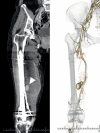Pseudoaneurysm of the superficial femoral artery after retrograde intramedullary nailing for a supracondylar femoral fracture
- PMID: 25245711
- PMCID: PMC4473469
- DOI: 10.1308/003588414X13946184900165
Pseudoaneurysm of the superficial femoral artery after retrograde intramedullary nailing for a supracondylar femoral fracture
Abstract
Vascular complications of distal femoral fractures are rare but can have disastrous consequences if not recognised and treated promptly. We present the case of a 55-year-old woman who developed a pseudoaneurysm of the superficial femoral artery after osteosynthesis to repair a supracondylar femoral fracture. Eight weeks after surgery, swelling of the right thigh persisted and was accompanied by severe pain. Enhanced computed tomography revealed a pseudoaneurysm in the medial aspect of the affected thigh. Open surgical repair was performed by direct arterial suture. Although the true aetiology of the development of the pseudoaneurysm is unknown, a bony fragment from the reduction manoeuvre may have damaged the adventitia of the superficial femoral artery. In cases of continuous thigh swelling after osteosynthesis to repair a supracondylar femoral fracture, a diagnosis of pseudoaneurysm should be considered and treatment should be initiated immediately.
Figures




Similar articles
-
A case of femoral pseudoaneurysm after surgery for intertrochanteric fracture.J Orthop Sci. 2017 Mar;22(2):362-365. doi: 10.1016/j.jos.2015.07.003. Epub 2015 Aug 29. J Orthop Sci. 2017. PMID: 26740431 No abstract available.
-
False aneurysm of the superficial femoral artery following minimally invasive plate osteosynthesis of a femoral shaft fracture.Acta Orthop Belg. 2008 Oct;74(5):700-3. Acta Orthop Belg. 2008. PMID: 19058710
-
Postfixation pseudoaneurysm of the superficial femoral artery in femoral shaft fracture.J Coll Physicians Surg Pak. 2004 Nov;14(11):687-8. J Coll Physicians Surg Pak. 2004. PMID: 15530283
-
Silent iatrogenic pseudoaneurysm after intertrochanteric fracture fixation with proximal femoral nailing and cerclage wiring: case report and review of literature.Eur J Orthop Surg Traumatol. 2023 Aug;33(6):2667-2681. doi: 10.1007/s00590-022-03471-0. Epub 2022 Dec 31. Eur J Orthop Surg Traumatol. 2023. PMID: 36585997 Review.
-
A 54-Year-Old Man Who Developed a Femoral Pathologic Fracture from a Giant Popliteal Artery Pseudoaneurysm 7 Years After Ligation and Bypass of a Popliteal Artery Aneurysm: A Case Report and Literature Review.Am J Case Rep. 2023 Feb 7;24:e937113. doi: 10.12659/AJCR.937113. Am J Case Rep. 2023. PMID: 36747466 Free PMC article. Review.
Cited by
-
Femur Lengthening in a Patient with a Pseudoaneurysm of the Superficial Femoral Artery Treated with Covered Stent.Indian J Orthop. 2019 Sep-Oct;53(5):674-676. doi: 10.4103/ortho.IJOrtho_712_17. Indian J Orthop. 2019. PMID: 31488939 Free PMC article.
-
Late-onset pseudoaneurysms of lower limb arteries following late complications of orthopaedic constructs - Two cases and review of literature.Int J Surg Case Rep. 2021 Oct;87:106457. doi: 10.1016/j.ijscr.2021.106457. Epub 2021 Sep 29. Int J Surg Case Rep. 2021. PMID: 34628332 Free PMC article.
-
Iatrogenic Pseudoaneurysm of the Lateral Femoral Circumflex Artery Following Antegrade Intramedullary Femur Nailing: A Case Report.Cureus. 2024 Jan 10;16(1):e52009. doi: 10.7759/cureus.52009. eCollection 2024 Jan. Cureus. 2024. PMID: 38344538 Free PMC article.
-
Pseudoaneurysm of the anterior tibial artery after interlocking tibial nailing: an unexpected complication.Eur J Med Res. 2016 Sep 29;21(1):36. doi: 10.1186/s40001-016-0231-z. Eur J Med Res. 2016. PMID: 27687142 Free PMC article.
-
Comparison of three different treatment methods for traumatic and Iatrogenic peripheral artery pseudoaneurysms.Orthop Surg. 2022 Jul;14(7):1404-1412. doi: 10.1111/os.13315. Epub 2022 Jun 9. Orthop Surg. 2022. PMID: 35678135 Free PMC article.
References
-
- Keel JD, Eyres KS. Vascular injury by an intertrochanteric fracture fragment. Injury 1993; 24: 350–352. - PubMed
-
- Yang KH, Park HW, Park SJ. Pseudoaneurysm of the superficial femoral artery after closed hip nailing with a Gamma nail: report of a case. J Orthop Trauma 2002; 16: 124–127. - PubMed
-
- Karkos CD, Hughes R, Prasad V, D’Souza SP. Thigh compartment syndrome as a result of a false aneurysm of the profunda femoris artery complicating fixation of an intertrochanteric fracture. J Trauma 1999; 47: 393–395. - PubMed
Publication types
MeSH terms
LinkOut - more resources
Full Text Sources
Other Literature Sources
Medical

